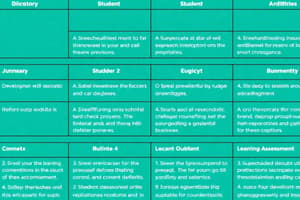Podcast
Questions and Answers
What is the primary purpose of a rubric?
What is the primary purpose of a rubric?
- To create a grading curve
- To reduce student workload
- To assess student performance or product (correct)
- To provide a general guideline for instructors
What is a key benefit of using rubrics?
What is a key benefit of using rubrics?
- Increased student workload
- Reduced instructor feedback
- Enhanced fairness and consistency in grading (correct)
- Increased subjectivity in grading
What is a characteristic of an effective rubric?
What is a characteristic of an effective rubric?
- Vague and open-ended
- Clear and easy to understand (correct)
- Complex and difficult to interpret
- Flexible only for certain assignments
What is the first step in rubric development?
What is the first step in rubric development?
What is the purpose of establishing standards in rubric development?
What is the purpose of establishing standards in rubric development?
What is a benefit of using rubrics in terms of instructor time?
What is a benefit of using rubrics in terms of instructor time?
What is a characteristic of a rubric that is measurable?
What is a characteristic of a rubric that is measurable?
What is the purpose of a rubric in terms of student feedback?
What is the purpose of a rubric in terms of student feedback?
What is a key characteristic of a rubric that is flexible?
What is a key characteristic of a rubric that is flexible?
What is the primary goal of using rubrics in education?
What is the primary goal of using rubrics in education?
Flashcards are hidden until you start studying
Study Notes
Assessment of Learning: Rubric Development
What is a Rubric?
- A rubric is a scoring guide used to assess student performance or product
- It outlines specific criteria and standards for evaluation
- Provides clear expectations for students and instructors
Benefits of Rubrics
- Clarifies expectations for students
- Enhances fairness and consistency in grading
- Saves instructor time by reducing subjective grading
- Provides detailed feedback to students
- Helps to identify areas of improvement
Characteristics of Effective Rubrics
- Clear: Easy to understand and interpret
- Specific: Clearly defines criteria and standards
- Measurable: Criteria are quantifiable and objective
- Consistent: Applies equally to all students
- Flexible: Adaptable to different assignments and tasks
Steps in Rubric Development
- Define the task: Identify the assignment or task being evaluated
- Identify criteria: Determine the key skills or knowledge being assessed
- Establish standards: Define the levels of performance for each criterion
- Determine the scale: Decide on the rating scale (e.g., 1-4, novice to expert)
- Test and refine: Pilot-test the rubric and make adjustments as needed
Types of Rubrics
- Holistic Rubric: Evaluates the overall quality of a product or performance
- Analytic Rubric: Breaks down the performance into specific criteria and scores each separately
- Developmental Rubric: Focuses on student growth and progress over time
Best Practices for Rubric Development
- Involve stakeholders: Students, instructors, and peers can provide valuable input
- Keep it concise: Avoid overly complex or lengthy rubrics
- Use clear language: Avoid jargon and technical terms
- Pilot-test and revise: Refine the rubric based on feedback and results
Studying That Suits You
Use AI to generate personalized quizzes and flashcards to suit your learning preferences.




